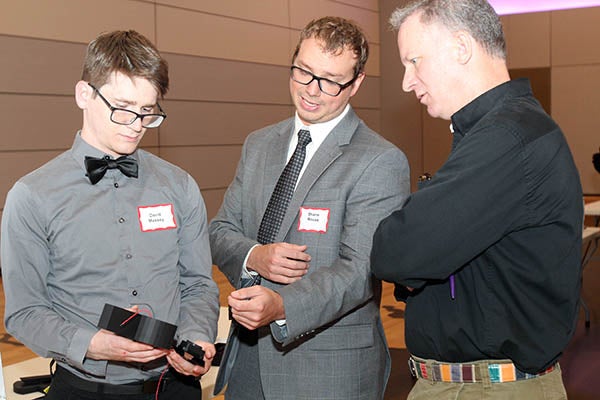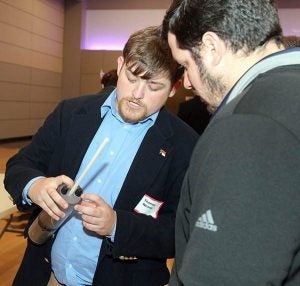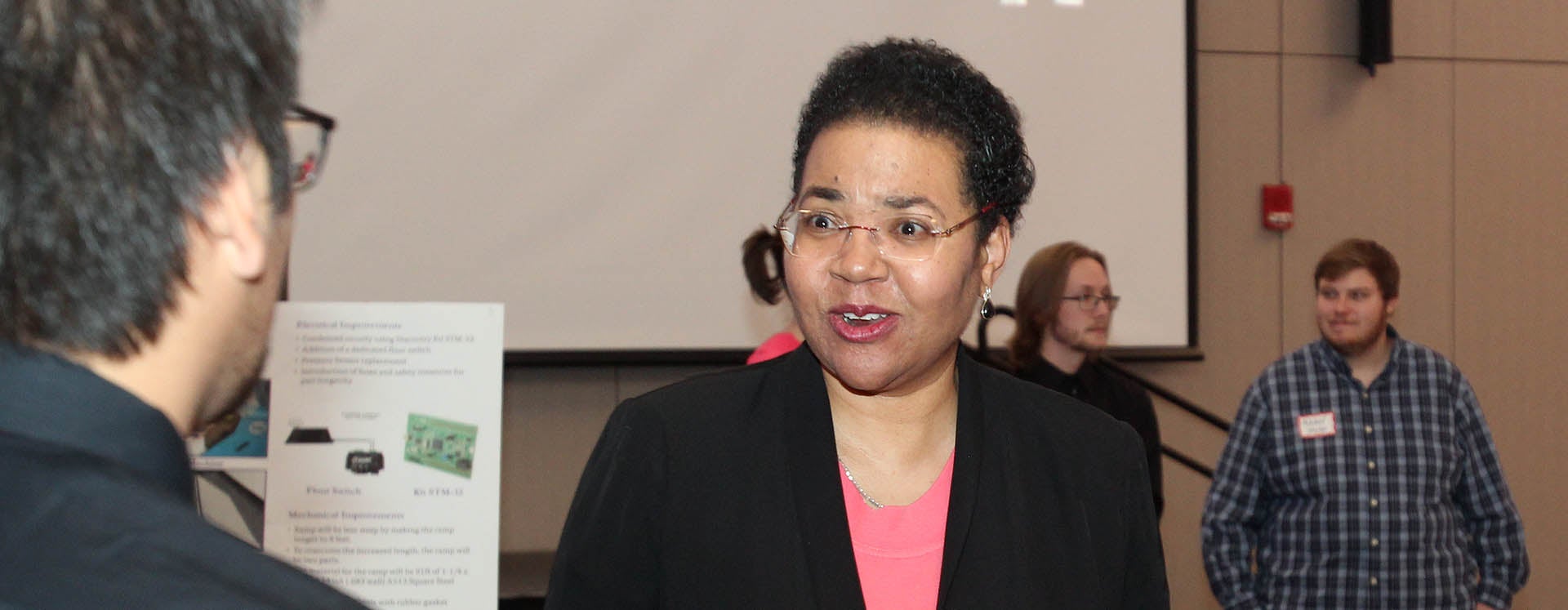MAKING THINGS BETTER
ECU senior engineering students showcase capstone projects
Senior engineering students tackled a wide variety of capstone projects, but the overall theme of Monday’s Engineering Capstone Symposium centered on making things better for people and the environment.
Twenty-two teams from the Department of Engineering set up displays in the Main Campus Student Center, but one was too large to fit inside. Parked outside the center, Pee Dee’s Sensory Trailer is designed to be a mobile station with calming sensory intervention devices that will give those with neurodivergent issues a place to ground themselves and regain control of their emotions at ECU sporting events or community events.

Student Austin McAllister highlights some of the tactile games available inside a mobile sensory trailer.
Students Josh Ali-Martinez, Meredith Bullard, Crawford Chandler, Sarah Hicks and Austin McAllister spent this semester taking an empty trailer and creating a carpeted, calming room with tactile games, soft places to sit and other sensory materials, including a bubble tube.
“The first time we saw the trailer, we thought, ‘Man, we have a lot to do,’” McAllister said. “We got the carpeting in, we painted and we got some of our devices in. It’s very fulfilling knowing that these kids will have something to have like this.”
The team had to wire the trailer for power, making sure to put electrical outlets high on the walls so they would not be a shock hazard for children. They also realized they needed a larger generator to power the air-conditioning unit and lights inside the trailer, which has no windows.
The team believes the completed trailer will be ready for ECU’s first home football game on Sept. 9, and though he will have graduated by then, McAllister believes he may just come back to check it out.
“I’ve been coming to ECU football games since I was little, so I am definitely going to come and check it out,” McAllister said.
Making Waves
Nicole Obando, Cody Whaley, Erica Walker and James Sebree worked on another project designed mainly for children. The N.C. Museum of Natural Sciences tasked them with creating a mechanical water feature for a monarch butterfly exhibit. They designed it similar to water parks that feature buckets that fill with water and then tip over.
“We went through a few different designs, and as we were coming up with the designs, we were testing it and seeing what worked and what didn’t work,” Sebree said. “We had to figure out a good weight distribution for the water.”

Engineering students Nicole Obando, Cody Whaley, Erica Walker and James Sebree constructed this prototype of a water feature for a monarch butterfly exhibit.
As the water pours from one bucket to another, the weight shifts on an aluminum see-saw with a flower on the end that rises and falls.
“They have a lot of school groups out there, and they wanted something to show off some engineering aspects and some STEM, so they wanted some sort of mechanical motion just to get kids looking at it so they could wonder how it works,” Walker said.
As for what was the most fun aspect of the project, Obando summed it up. “Seeing it work,” she said. “There was some singing and dancing.”
Not All Wet
Delta Howard, Leah Hulett, David Kittrell, Victoria Rivera-Mangual, Michael Barnes and Joseph Lane worked with ECU geological sciences to bring new life to an old device. The rainwater sampler is designed to collect volatile organic compounds so that the amount of pollutants in rainwater can be measured.
“We had to make it functional again. It hadn’t been used in about 20 years,” Hulett said. “We needed to do some upgrading to make it better.”
The team looked at every aspect of the device including sensors, gears, sprockets, water storage system, motor and control system.
“The motor and gear calculations definitely caused some issues because we didn’t have a lot to go on because it was originally a nitrogen and piston system,” Rivera-Mangual said. “That was the biggest change we made to the original system was going to an electric motor and calculating the electric supply that would keep the motor and the control system going.”
Breath of Fresh Air

Engineering students David Massey, left, and Shane Rouse, center, explain their team’s aerosol monitoring device to senior teaching instructor Jeff Foeller.
David Massey, Shane Rouse, Jacob Sanders and Matthew Stengrim worked to develop an aerosol monitoring device that uses information from digital photographs to measure aerosol concentrations.
“We built it based off an existing device that used infrared lasers,” Stengrim said. “Essentially, we tried to swap out those components with just a plain old digital camera and LED laser, so it would be cheaper.”
However, cheaper doesn’t always mean better, but it worked in this case.
“We were able to take it to an aerosol lab in the public health department and compare our results to some existing equipment,” Stengrim said. “Fortunately, we were able to show that this more or less came up with the same results, so it turned out alright.”
The team upgraded in several areas, including a fan to draw in more air, and believes the device can play a key role.
“The importance of this is because of health and the occupational environment,” Stengrim said. “People will want to know what the air quality is like. One day if this technology can be further developed, our sponsor hopes that it can be shrunk down to be a smart phone attachment where the brains and the camera would be your smart phone, making it much more accessible than what’s out there today.”
Digging Deep

Student Thomas Weaver explains his team’s redesigned lid for a sediment incubation chamber.
Teammates Spencer Mullett, Josh Sutton, Thomas Weaver and Jack Westbrook helped upgrade a device used to measure nitrogen levels in sediment. The lid on the current incubation chamber through which a tube samples the soil didn’t offer enough flexibility to allow for consistent access to measure nitrogen within the top two centimeters of the soil.
“In the original design, the length of the tube was always at a set distance from the cap top, so you would have to push the lid down to get the tube to the surface of the dirt,” Mullett said. “We came up with a simple solution to a simple problem. Instead of having to go up and down adjusting the cap, they just have to adjust the tube while maintaining the water-tight device.”
Weaver said the team learned a lot from the project.
“As young engineers, we have this somewhat backwards approach to solving a problem,” he said. “We thought we would design a solution and find the parts to fit it. That’s exactly backwards of what you should be doing. You have to go out there and find parts that you can actually get and then start designing your solution. That was the big thing.”
Weaver said good communication among the team members and the project sponsors proved to be the key to success.
“That was so important to how quickly we got this achieved,” he said.
The capstone projects had a variety of sponsors, including some from other ECU colleges and departments, such as the Brody School of Medicine and the Water Resources Center, to outside companies and businesses such as Fleet Readiness Center East at Cherry Point, Sizzlefish and Mann + Hummel.

Dr. Robin Coger, provost of East Carolina University, talks to students about their projects during the Engineering Capstone Symposium.
